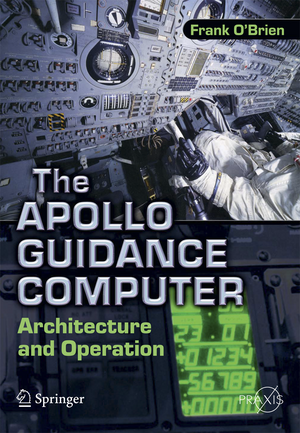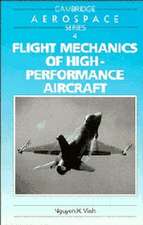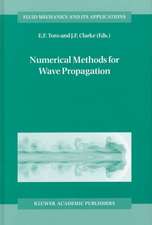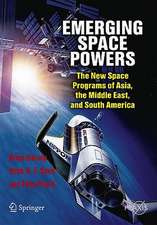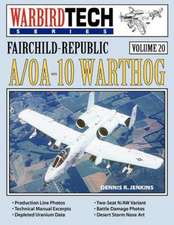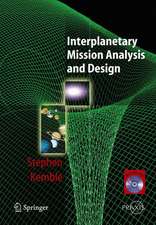The Apollo Guidance Computer: Architecture and Operation: Springer Praxis Books
Autor Frank O'Brienen Limba Engleză Paperback – 12 iul 2010
This is the first book to fully describe the Apollo guidance computer’s architecture, instruction format and programs used by the astronauts. As a comprehensive account, it will span the disciplines of computer science, electrical and aerospace engineering. However, it will also be accessible to the ‘space enthusiast’. In short, the intention is for this to be the definitive account of the Apollo guidance computer.
Frank O’Brien’s interest in the Apollo program began as a serious amateur historian. About 12 years ago, he began performing research and writing essays for the Apollo Lunar Surface Journal, and the Apollo Flight Journal. Much of this work centered on his primary interests, the Apollo Guidance Computer (AGC) and the Lunar Module. These Journals are generally considered the canonical online reference on the flights to the Moon. He was then asked to assist the curatorial staff in the creation of the Cradle of Aviation Museum, on Long Island, New York, where he helped prepare the Lunar Module simulator, a LM procedure trainer and an Apollo space suit for display. He regularly lectures on the Apollo computer and related topics to diverse groups, from NASA's computer engineering conferences, the IEEE/ACM, computer festivals and university student groups.
Din seria Springer Praxis Books
-
 Preț: 294.46 lei
Preț: 294.46 lei -
 Preț: 223.45 lei
Preț: 223.45 lei -
 Preț: 193.12 lei
Preț: 193.12 lei -
 Preț: 167.85 lei
Preț: 167.85 lei -
 Preț: 288.98 lei
Preț: 288.98 lei -
 Preț: 323.74 lei
Preț: 323.74 lei -
 Preț: 376.08 lei
Preț: 376.08 lei -
 Preț: 264.12 lei
Preț: 264.12 lei - 8%
 Preț: 517.61 lei
Preț: 517.61 lei -
 Preț: 190.01 lei
Preț: 190.01 lei -
 Preț: 218.16 lei
Preț: 218.16 lei -
 Preț: 312.06 lei
Preț: 312.06 lei - 17%
 Preț: 401.17 lei
Preț: 401.17 lei -
 Preț: 216.41 lei
Preț: 216.41 lei -
 Preț: 262.27 lei
Preț: 262.27 lei -
 Preț: 264.35 lei
Preț: 264.35 lei -
 Preț: 167.63 lei
Preț: 167.63 lei -
 Preț: 259.52 lei
Preț: 259.52 lei -
 Preț: 259.08 lei
Preț: 259.08 lei -
 Preț: 305.47 lei
Preț: 305.47 lei -
 Preț: 234.01 lei
Preț: 234.01 lei -
 Preț: 227.85 lei
Preț: 227.85 lei -
 Preț: 259.95 lei
Preț: 259.95 lei -
 Preț: 295.56 lei
Preț: 295.56 lei -
 Preț: 357.17 lei
Preț: 357.17 lei -
 Preț: 275.79 lei
Preț: 275.79 lei -
 Preț: 257.08 lei
Preț: 257.08 lei -
 Preț: 349.71 lei
Preț: 349.71 lei -
 Preț: 272.45 lei
Preț: 272.45 lei -
 Preț: 270.27 lei
Preț: 270.27 lei - 8%
 Preț: 433.24 lei
Preț: 433.24 lei -
 Preț: 327.03 lei
Preț: 327.03 lei - 8%
 Preț: 394.80 lei
Preț: 394.80 lei -
 Preț: 320.65 lei
Preț: 320.65 lei -
 Preț: 325.29 lei
Preț: 325.29 lei -
 Preț: 253.11 lei
Preț: 253.11 lei -
 Preț: 192.86 lei
Preț: 192.86 lei -
 Preț: 313.40 lei
Preț: 313.40 lei -
 Preț: 150.51 lei
Preț: 150.51 lei -
 Preț: 233.34 lei
Preț: 233.34 lei -
 Preț: 286.78 lei
Preț: 286.78 lei -
 Preț: 212.01 lei
Preț: 212.01 lei -
 Preț: 366.83 lei
Preț: 366.83 lei -
 Preț: 274.68 lei
Preț: 274.68 lei -
 Preț: 232.27 lei
Preț: 232.27 lei -
 Preț: 284.58 lei
Preț: 284.58 lei -
 Preț: 212.45 lei
Preț: 212.45 lei -
 Preț: 159.81 lei
Preț: 159.81 lei -
 Preț: 349.48 lei
Preț: 349.48 lei - 20%
 Preț: 2061.61 lei
Preț: 2061.61 lei
Preț: 321.12 lei
Nou
Puncte Express: 482
Preț estimativ în valută:
61.45€ • 63.77$ • 51.36£
61.45€ • 63.77$ • 51.36£
Carte disponibilă
Livrare economică 22 februarie-08 martie
Livrare express 11-15 februarie pentru 91.57 lei
Preluare comenzi: 021 569.72.76
Specificații
ISBN-13: 9781441908766
ISBN-10: 1441908765
Pagini: 300
Ilustrații: XVIII, 440 p. 30 illus.
Dimensiuni: 170 x 240 x 30 mm
Greutate: 0.78 kg
Ediția:2010
Editura: Praxis
Colecția Praxis
Seriile Springer Praxis Books, Space Exploration
Locul publicării:New York, NY, United States
ISBN-10: 1441908765
Pagini: 300
Ilustrații: XVIII, 440 p. 30 illus.
Dimensiuni: 170 x 240 x 30 mm
Greutate: 0.78 kg
Ediția:2010
Editura: Praxis
Colecția Praxis
Seriile Springer Praxis Books, Space Exploration
Locul publicării:New York, NY, United States
Public țintă
Popular/generalCuprins
History, evolution and packaging.- Machine organization.- Interpretive instructions.- The executive program.- Important background routines.- Display and keyboard (DSKY).- I/O devices and interfaces.- Application programs.- Erasable memory programs.- Interaction with the ground.- Selected case studies.- Epilogue.
Recenzii
From the reviews:
“This exceedingly valuable work will give present day Computer Science students the background to understand how the dramatic breakthroughs in Logical Design, Computer Architecture, Computer Language Interpreters and Real-Time Executive Software was invented, and how it worked in practice. … This excellent reference will form a model for teaching and learning historical Computer Architectures and Software so that future Computer Scientists can understand and learn the original ideas that today guide their field.” (Ira Laefsky, Amazon, September, 2010)
“This exceedingly valuable work will give present day Computer Science students the background to understand how the dramatic breakthroughs in Logical Design, Computer Architecture, Computer Language Interpreters and Real-Time Executive Software was invented, and how it worked in practice. … This excellent reference will form a model for teaching and learning historical Computer Architectures and Software so that future Computer Scientists can understand and learn the original ideas that today guide their field.” (Ira Laefsky, Amazon, September, 2010)
Notă biografică
Frank O’Brien’s interest in the Apollo program began as a serious amateur historian. About 12 years ago, he began performing research and writing essays for the Apollo Lunar Surface Journal, and the Apollo Flight Journal. Much of this work centered on his primary interests, the Apollo Guidance Computer (AGC) and the Lunar Module. These Journals are generally considered the canonical online reference on the flights to the Moon. He was then asked to assist the curatorial staff in the creation of the Cradle of Aviation Museum, on Long Island, New York, where he helped prepare the Lunar Module simulator, a LM procedure trainer and an Apollo space suit for display. He regularly lectures on the Apollo computer and related topics to diverse groups, from NASA's computer engineering conferences, the IEEE/ACM, computer festivals and university student groups.
Textul de pe ultima copertă
By today's standards, the on-board computer used by the Apollo astronaut's was a primitive affair, but in an age when most computers filled an entire room, this was small, required little power, and incorporated several technologies that were revolutionary for its time.This is the first book to fully describe the Apollo guidance computer's architecture, Executive software, and the programs used by astronauts. It describes the full range of technologies required in order to fly the Apollo lunar missions, and whicn enabled the astronauts to fly to the Moon - and back!
Caracteristici
The first comprehensive description of the Apollo guidance computer, ranging from its internal organisation to its user interface and flight software Describes the technologies required in order to fly the Apollo lunar missions It is primarily space history, but crosses into computer science and electrical and aerospace engineering sufficiently to appeal to these professional interests Includes supplementary material: sn.pub/extras
